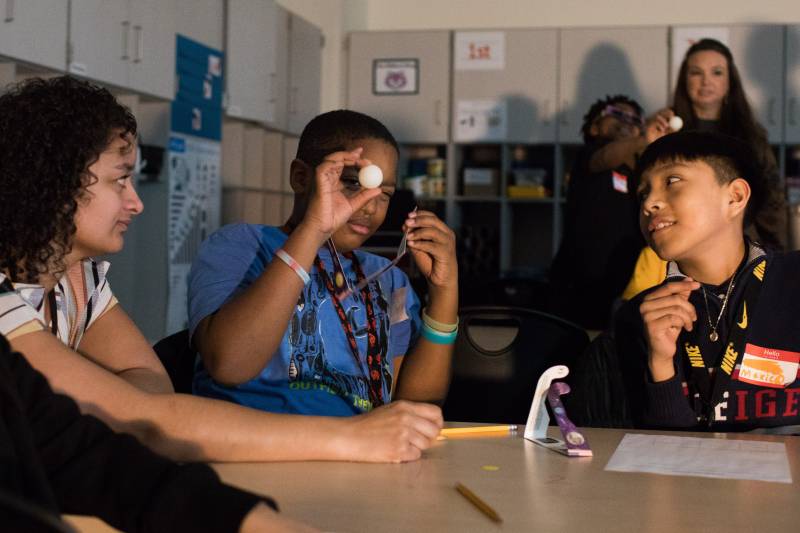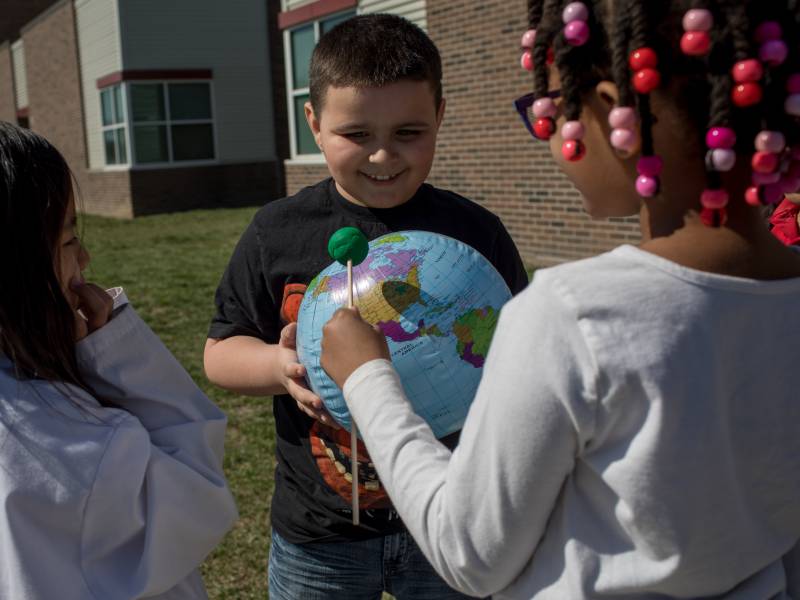How a second-grade teacher uses a solar eclipse to inspire her students

[ad_1]
It’s an experience you expect them to remember for the rest of their lives.
“This is a story you’ll be able to tell,” she muses before class.
“You, as a second-grader, encountered all of this.”
In a grassy area outside the school, Cummings’ eclipse simulation begins: Students take turns holding inflatable globes, casting shadows with their dough moons. Cummings directs them to point the shadow at where Indianapolis would be on the globe. It was a bit messy, but the students quickly figured out how to properly place the moon’s shadow over their city.
“Good job guys, you’re really smart,” one student tells his friends.
How an eclipse can inspire a career in science
Thomas Hockey, an astronomy professor at the University of Northern Iowa, remembers his first eclipse experience fondly. On March 7, 1970, when Hockey was 10 years old, he witnessed a partial solar eclipse outside his home in Angola, Indiana, a two-and-a-half-hour drive north of Indianapolis.
It had been nearly a year after the Apollo program had put the first people on the moon, and hockey’s interest in space was already developing. But he attributes this partial eclipse as one of the reasons that prompted him to choose to study astronomy.
“It was amazing, as more and more of the sun disappeared, creating a strange shape,” Hockey recalls.
It also sparked a fascination with eclipses. Hockey would go on to become a so-called umbraphile—someone who chases eclipses all over the world—and he recently published a book on the history of eclipse chases.
Hockey says he didn’t learn about solar eclipses when he was in elementary school. He believes the fact that elementary school teachers like Cummings are now teaching about it is an indication that science education has improved since he was a child.

It’s also an opportunity to show kids that science doesn’t happen behind closed doors.
“Science isn’t necessarily done by grey-haired old people in lab coats. Citizens can participate in it. It’s not a magic black box, it’s all around us,” says Hockey.
The total solar eclipse on April 8 will be hockey’s ninth. He plans to bring a group of college students with him to experience college in his home state of Indiana. Some of them plan to become science teachers, he says.
“So they’ll talk about the eclipse to their students, and maybe we’ll have a new generation of astronomers who will be inspired by the eclipse,” Hockey says.
Another important lesson: eclipse safety
For Cummings, teaching her students how to view the eclipse safely is a top priority.
“The only glasses you should use are solar eclipse glasses to look at the sun safely,” she told her class.
Exposure to sunlight without proper protection It can cause permanent damage Retina. But during a total eclipse, which lasts only a few minutes, you won’t be able to see the sun’s corona with those eclipse glasses on. A total eclipse is the only part of the eclipse that can be viewed without it.

Outside, her students take turns trying on glasses and looking at the sun. They scream in excitement as they stare at the unfamiliar orb.
“If you look up and see that orange thing over there — it looks like a street light,” says second-grader Jair Tate.
Cummings’ district, Perry Township Schools, is one of several school systems in Indianapolis that has chosen to make April 8 a remote learning day.
The district says the decision is an effort to keep kids safe: In Indianapolis, the eclipse will become visible around 1:50 p.m., and totality will begin at about 3:06 p.m. — around the time of dismissal from school.
“Traffic is going to be pretty congested…we don’t want buses and cars stuck on the road,” says Elizabeth Choi, director of communications for Perry Township Schools.
Cummings tells her students that they can ask their parents to purchase eclipse glasses online or at local stores, such as Kroger. Or, she says, they can watch a live stream of the eclipse on YouTube.
But Hockey hopes these kids will get a chance to get outside during the eclipse. Even without eclipse glasses, they can make it, he says Pinhole Viewer With a few common household supplies that will allow them to watch the event safely.
[ad_2]
Source link



